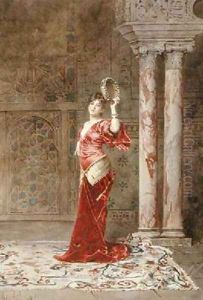Louise Leloir Paintings
Louise Leloir was a notable French painter and illustrator, born in Paris in 1848. She hailed from a family deeply entrenched in the world of art, which significantly influenced her career and style. Her father, Auguste Leloir, was a respected painter, and her uncle, Alexandre Colin, was also a celebrated artist of his time. This environment nurtured her talents from a young age, enabling her to develop a distinctive style that combined elements of realism and romanticism. Louise was particularly known for her detailed and vibrant watercolors and oil paintings, which often featured scenes of daily life, portraits, and historical themes.
Throughout her career, Louise Leloir made significant contributions to the art world, not just through her paintings but also as an illustrator. She contributed illustrations to various publications and books, showcasing her versatility and skill in different mediums. Her work was widely appreciated for its attention to detail, color, and ability to convey emotion and narrative.
Despite the challenges faced by women artists in the 19th century, Leloir managed to carve out a respected place for herself in the French art scene. She regularly participated in art exhibitions and was recognized by her peers and critics alike for her artistic talents. Her contributions were not limited to her personal achievements but also extended to inspiring future generations of artists, particularly women, by breaking through the gender barriers of her time.
Louise Leloir's legacy is preserved through her artworks, which continue to be celebrated for their beauty and emotional depth. She passed away in 1925, leaving behind a body of work that remains influential in the study of 19th-century French art. Her life and work are a testament to her skill, dedication, and the role of women in the development of art during her era.
